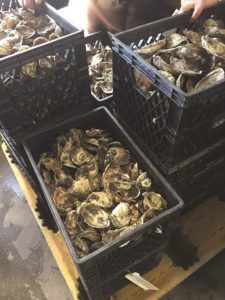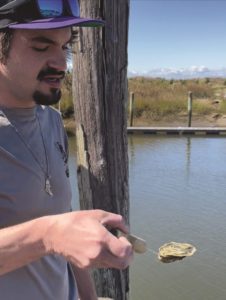WELLFLEET — Shellfish from Outer Cape Cod may soon make its way to Europe again after a 12-year hiatus. What that means for local growers is not yet clear, but so far at least one wholesaler here is working to make the overseas connections that would allow Cape Cod oysters and clams to appear on tables in the European Union by next winter.
Alex Hay, president of the Wellfleet Shellfish Company in Eastham, says it will take time, but he anticipates that reopening trade with the E.U. will be “a good thing for everyone.”
The shellfish trade between the U.S. and the European Union ground to a halt in 2010 because of a dispute over differences in food safety controls. But on Feb. 27, European markets reopened to wholesalers from Massachusetts and Washington state. Sellers in other states will also soon be eligible to export, according to the U.S. Food and Drug Administration.
At the same time, we may be seeing mussels coming here from Spain or the Netherlands, both significant producers of those mollusks, as those two countries will now be allowed to export shellfish to the U.S.

This reopening concludes more than a decade of back-and-forth “dithering” over whether the safety controls imposed by the U.S. Food and Drug Administration (FDA) are equivalent to the system used by the E.U.’s food safety regulatory authority, said Bob Rheault, executive director of the East Coast Shellfish Growers Association. Rheault, based in Rhode Island, has spent the past 12 years urging policymakers in Washington, D.C. to reopen the European market to producers here.
“The main hangup was that the E.U. samples their shellfish meats,” he said, “while our sanitation program is based on sampling the waters.” Statisticians had to sit down and look at the two different programs, he said, and in September 2020 the U.S. and E.U. finally agreed that their safety control systems were equivalent.
Rheault doesn’t anticipate a “gold rush” into the E.U. anytime soon. He said he is not even sure what the European market is worth to American sellers. “All I can say honestly is that, before things closed, we were shipping somewhere between $1 million to $3 million worth of clams to Spain per year,” Rheault said, referring to Rhode Island clam growers.
Hay said he also is unsure of the European market potential. But he sees expanding into Europe as a way to “keep the pressure off of local markets,” where prices can drop if supply exceeds demand. He said that’s why his business already focuses on distributing widely beyond Cape Cod. With the E.U. reopening, his hope is to further improve prices for local growers.
That’s likely going to take some time. While trade officially resumed last week, Rheault estimated it will be months before shellfish distributors can fly oysters, clams, mussels, and scallops across the pond.
Massachusetts companies now face the task of transatlantic relationship-building — or, as Rheault put it: “Sending over an emissary to kiss the right ass and pay the right money to get the right customs broker so that your stuff doesn’t end up rotting on the docks for two weeks.”
Searching for that customs whiz will mean schmoozing around seafood expos in Brussels and Barcelona, and wholesalers will also need to negotiate credit lines and quantities with European buyers.
“Flying live rocks around the planet is heavy, not to mention expensive,” Rheault said. “If you’re going to make this work, you need to be sending a whole pallet — which is roughly a ton.”
Stateside, there’s plenty of red tape, too — namely going through a federal seafood inspection created especially for the European market and nailing down various certificates that qualify a distributor for export.
Chris King, owner of Cape Tip Seafood, a Provincetown wholesaler, says he is not interested in gearing up to sell to the European market. Instead, he says, his focus is to supply Cape Cod restaurants and markets. Holbrook Oyster, a smaller wholesaler, is also sticking to the Cape, according to owner Zack Dixon.
One reason Hay said he is hopeful has to do with the seasonality of the shellfishing industry. He said he expects prime time for exports to the E.U. to hit in the fall, between October and December — that time of year when “being a shellfish wholesaler is one of the worst jobs in the whole world,” he told the Independent.
Rheault agreed, explaining that’s when the wild harvest opens on the East Coast, ramping up competition with wholesalers, which in turn drives down the price of cultured shellfish. “The cheap product floods the market,” Rheault said. “We can’t sell the premium cultured oyster at all, not until the wild harvest gets exhausted.”
But Rheault hopes that a few years from now wholesalers will be able to send their autumn supply off just as “everybody in Europe is stocking up on oysters for Christmas.
“It was a slow-rolling train,” he said. “I certainly didn’t think it would take 12 years to get things reopened. But, hopefully, this will help create more demand and raise prices. And the phone will be ringing a bit more.”


